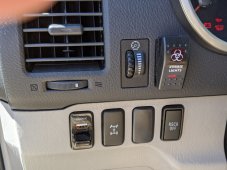Ah, got it. The Diesel is 12 V. The Solar / House battery system I am installing is 24V. Hence the 12V (starter / alternator) to 24V (house battery side) DC to DC charger.
The converter which I pointed to (above) is a "buck" converter only - 24V "truck" engine battery packs to LOWER a lower voltage "house" battery pack. You'll be needing the Orion-Tr 12/24-15 or equivalent, and I see what you mean about the long "12v" run occurring before the much shorter connection of battery cables. Their data sheet (
here) indicates an output "short circuit" current of up to 40A, so you will need to fuse the 12v input wire at a small value (input current is apparently NOT directly limited within the Victron device).
I can describe a better configuration for you, which WILL limit input current more effectively (but it costs more): Near the starter/alternator battery pack, you'd put in one of these (I own the 36 volt black "15A" model, located in a well-ventilated location under my SUV hood).
https://www.ebay.com/itm/313886333480. Although that's nominally good for "up to 540 watts", I use an MPPT Solar Controller, limited to lower output wattage (via the current limit parameter) to keep the boost converter running at less than about 85% maximum rated power (459 watts of output).
The engine compartment of my SUV is grimy and nasty, perhaps similar to your "starter battery" location. In my configuration (which haw been running great, for many years) the 36.0 Volt output travels all the way to-and-through the 7-pin Bargman plug and cable (the "trailer battery charge" wire), and then connects into MPPT. I have switch which allow me to enable/disable "high voltage" at the SUV dashboard, so that I can tow other Trailers - but you don't need that.
By putting with sealed "booster box" right next to the batteries, you send 36 volts at far less current down your 8-AWG wire. that becomes input to the new and separate MPPT unit, connecting the LFP battery string and charging it as needed for a 24V LFP battery string. The MMPT should be current-limited, to keep from pulling more than 480 watts maximum down the long log wire (the "36V" supply wire will have roughly 35.6 volts at the end). At maximum power, you will be losing only 6 watts along the wire.
The MPPT will be around 92% efficient in converting from the 35.6 volts "fake panel" to the required and lower LFP charging voltage. We have about 459 watts * .092 = 422 watts available at the "24V" LFP output, possibly programmed to allow 28.8V in Boost = Bulk CV mode. (I have mine a bit lower than that, at only 14.2V for my "12V" LPF battery packs). The MPPT, with this particular boost converter, would be limited to 14.7 maximum output amps.
- - -
I have a cheap and less controllable r EpEver "Tracer BN" in my own configuration, my dashboard switch automatically shuts off the "36 V enable" dashobard switch when ignition is powered off. But Victron, such as the MPPT 100/30 would give the option of powering on/powering off via bluetooth, avoiding any need for a switch like mine (useful when the Bus isn't being used, to avoid dragging down the "starter" battery pair).
For your amusement, here is a photo of my "36 enable" switch in the dashboard (the one at the upper right):



